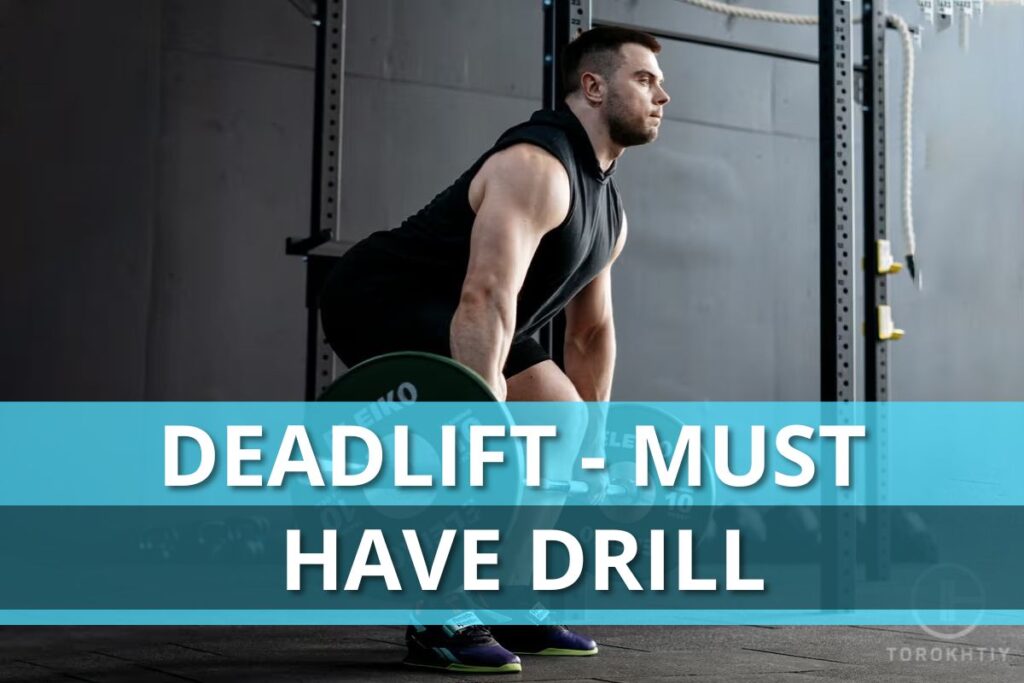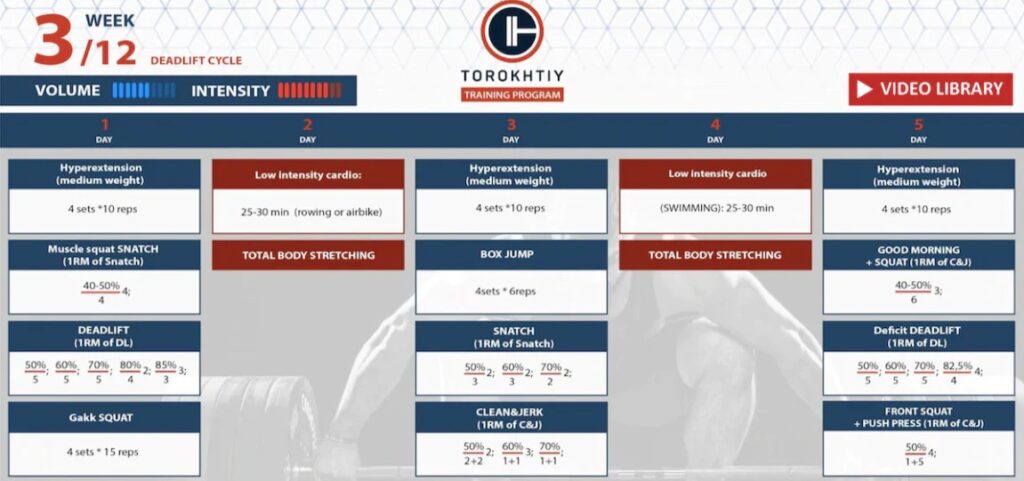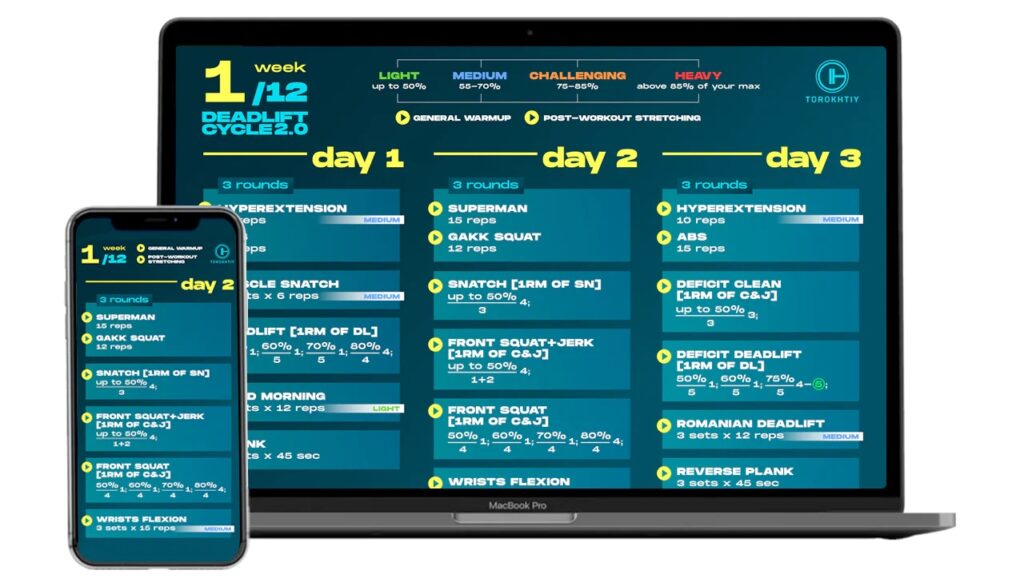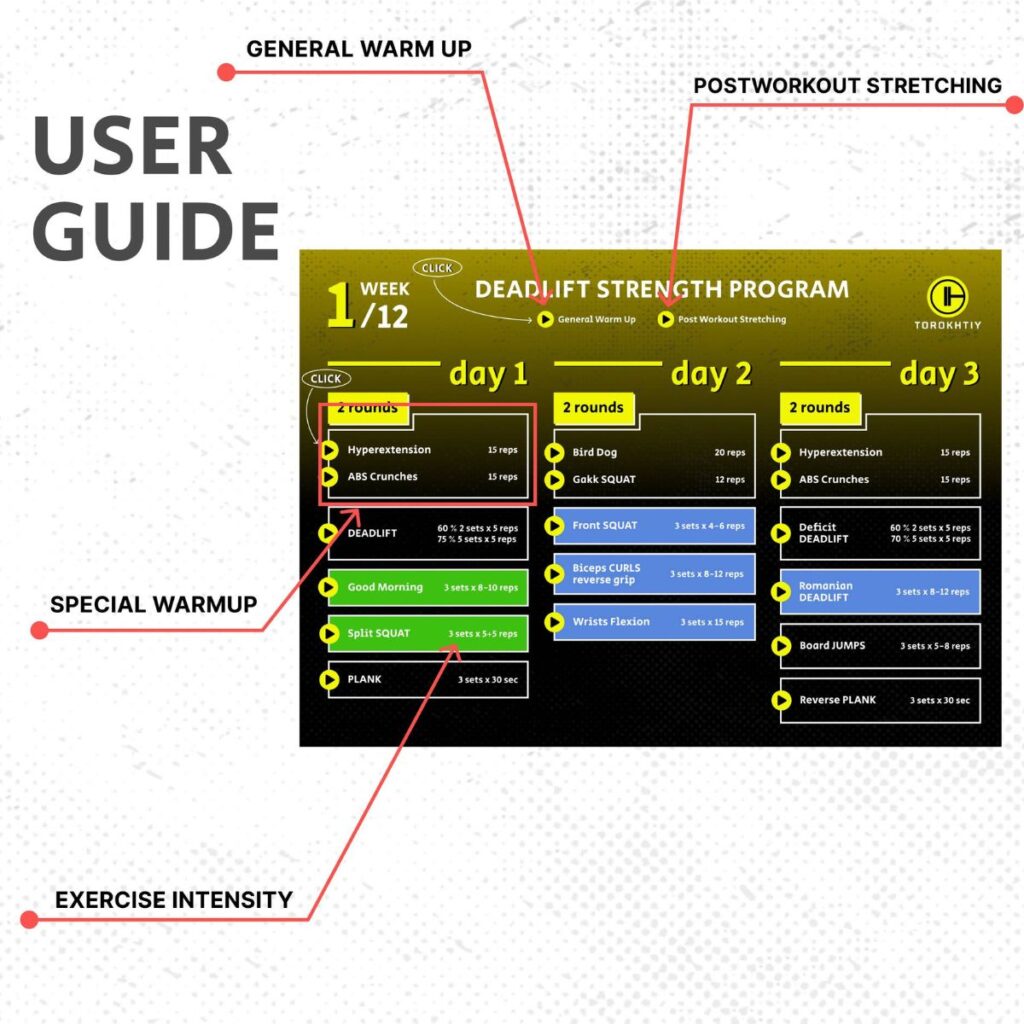Deadlift – Must Have Drill
Author:
Unlock your full potential by engaging with our experts and community! Have questions about your fitness journey or looking for expert advice on weightlifting techniques? Don’t hesitate — leave a comment below and Sergii Putsov will provide a personalized answer and insights to help you reach your goals.
Torokhtiy is reader-supported. Some links are affiliate links, and we may earn a commission at no extra cost to you. See our disclosure page for details.

This article also available as audio. Check this out!
Subscribe and listen it anywhere:
The deadlift is a must-have exercise for beginners since it builds up the strength of the biggest body muscles. Nevertheless, it is essential for advanced athletes too – the progress of all other exercises highly depends on leg and back strength. But for the sake of safety and significant results, you should stick to the proper technique at each stage.
The deadlift mainly involves:
You may like it:
- Detailed Olympic Weightlifting Program For Beginners
- 12-Week Weightlifting Program For Women (Detailed Example)
- Create Your Olympic Weightlifting Program (Examples Included)
- quadriceps;
- back flexors;
- glutes;
- hamstrings;
- lats.
Using particular variations of the deadlift, you can focus on different muscles. Each of them additionally involves finger flexors, biceps, rear delts, and traps.

Deadlift variations
Depending on the starting position and technique, we distinguish such kinds of the deadlift:
Standard or weightlifting. Use the shoulder-width stance.
It equally involves back muscles, glutes, and hamstrings. Both newbies and experienced athletes can use it.
Sumo. Use the wide stance, and point your toes outside in line with the knees to nearly touch the plates. In this case, you mainly aim your leg muscles. It suits advanced athletes and beginners, especially those who lack back strength.
The Romanian deadlift. Use the standard stance but barely bend your knees. If you find it difficult to keep the knees straight, you can bend them a little bit but don’t squat.

The Romanian deadlift actively involves hamstrings and upper glutes. It is recommended to experienced athletes with good technical skills and strong back muscles.
You can also try out different equipment.
A barbell. The kind of sport and standards (European or American) define the diameter, weight, and knurling.
A trap bar. It is a traditional deadlift variation with special equipment. A bar is a rhombus, hexagon, or octagon. There are two handles for the grip at the edges inside and sleeves for plates outside the bar. It is easier to control and keep your back straight due to the parallel grip. This option is comfortable for beginners and amateurs.
Follow us!

Free!
Get a 2-week Weightlifting Program as a bonus for the subscription to kickstart your training plan!

Free!
Dumbbells. This variation allows you to perform all kinds of deadlifts with different grips and lower weights. It involves more stabilizers than a barbell does.
Sometimes, athletes additionally use resistance bands or chains. They increase the load gradually during the upward movement creating the highest muscle tension in the final phase.
If you have a rather weak grip, small palms or short fingers, use different kinds of lifting straps. They are helpful for lifting heavy weights during training sessions though are banned at some competitions. Read more about how to use lifting straps in our guide.
There are a number of deadlift mistakes that at best prevent muscles from working properly. At worst, an athlete may get an injury.
The most dangerous mistakes are:
- Too narrow stance and pointing toes too far outside. Such a position reduces stability and increases the range of motion.
- The center of gravity is moved to the toes. A bar becomes difficult to drive off the platform, it puts a higher load on the back and increases the risk of injury.
- Not pushing knees out enough. Lifting a bar in this position overloads your knee joints and lower back which entails injuries in these areas. Knees must be strictly in line with toes.
- Asymmetric grip. Inexperienced athletes sometimes make this mistake in a rush or because of inattentiveness. It creates an imbalance in muscle tension, threatens stability, and provokes injuries.
- Curved back and tilted head. This position takes the load away from back muscles and puts it all on the lower back increases the risk of injuries too.
- Harsh hip lifting at the start and premature leg straightening. In this case, the weight is moved forward, suddenly overloading the lower back.
Find more helpful tricks for the deadlift here.
In my upgraded training program DeadLift Cycle 2.0., I’m sharing all the peculiarities of such workouts and teaching weightlifters to boost muscle strength using this exercise.
Our team released the first version of the program in 2017. Since then, approximately 700 athletes all around the world have finished it (some of them even managed to do it several times).

I am so delighted with such numbers as I realize that a lot of athletes have become stronger and set plenty of personal records.
We have learnt a lot of things about design and methodical information delivery. Moreover, our athletes’ feedback and suggestions have helped us make our programs convenient and, what is more important, effective and productive.
The updatings of DeadLift Cycle 2.0. are connected both with the visual side and working loads. Now, DeadLift Cycle completely corresponds to our training program “gold standards”.

Athletes will have such innovations:
- Interactive video library
- Pre and post-workout stretch
- Detailed special warm-up
- Auxiliary exercises to attack your weak points
- More exercises to strengthen your core
- Strength Training Reps and Sets Schemes
- Truly interactive design
- Mobile version for greater experience on a smartphone
- More information and details are available here.
In conclusion, I want to repeat one of my thoughts that I often say at my seminars. A HEAVY deadlift is a very vague term: for someone, it means lifting 300 kilos at a competition, or performing as many reps as possible after a set of burpees of pull ups, or simply straightening your body in the morning, for others, it is about a strength reserve for a powerful second pull and turnover in the snatch.
Related articles:
- 7 Essential Items For Every Olympic Weightlifter`s Gym Bag
- Top 5 Weightlifters Nutrition Mistakes
- Split Vs Power Jerk
- Power Position
You might be interested in:
Why Trust Us?
With over 20 years in Olympic weightlifting, strength training, nutrition coaching, and general fitness our team does its best to provide the audience with ultimate support and meet the needs and requirements of advanced athletes and professional lifters, as well as people who strive to open new opportunities and develop their physical capabilities with us.
By trusting the recommendations of our certified experts in coaching, nutrition, and sports training programming, as well as scientific consultants, and physiotherapists, we provide you with thorough, well-considered, and scientifically proven content. All the information given in the articles concerning workout programming, separate exercises, and athletic performance, in general, is based on verified data.
The product testing process is described in more detail here.
Author: Sergii Putsov
Head of Sport Science, PhD
Best Results: Snatch – 165 kg,
C&J – 200 kg
Sergii Putsov, Ph.D., is a former professional weightlifter and National team member, achieving multiple medals in the 94 kg weight category at national competitions. With a Master’s degree in “Olympic & Professional Sport Training” and a Sport Science Ph.D. from the International Olympic Academy, Greece, Sergii now leads as the Head of Sport Science. He specializes in designing training programs, writing insightful blog articles, providing live commentary at international weightlifting events, and conducting educational seminars worldwide alongside Olympic weightlifting expert Oleksiy Torokhtiy.









Still have questions after reading our article? Unlock your full potential by engaging with our experts and community! Don’t hesitate — leave a comment below and Sergii Putsov will provide a personalized answer and insights to help you reach your goals.